Insurance Law: Analyzing Tort Nuisance, Contract & Delegated Authority
VerifiedAdded on 2023/05/30
|25
|7516
|160
Essay
AI Summary
This essay provides a comprehensive analysis of several key areas within insurance law. It begins by examining the tort of nuisance, specifically private nuisance, in the context of a homeowner affected by a neighboring business's noisy machinery, discussing elements of unreasonableness, causation, and injury, and potential remedies like injunctions and damages. The essay then delves into contract law, focusing on the obligations of parties in an insurance contract, particularly the timely payment of premiums, and the implications of breaching those obligations, including the insurer's duty of good faith. Furthermore, it explores delegated underwriting, methods of contract termination, and the impact of a managing director's death on a company's operations. The essay also discusses insurable interests in various relationships (family, creditors) and the consequences of providing false information on insurance applications under the Insurance Act 2015. Finally, it addresses the importance of due diligence in motor vehicle insurance, the legal implications of worn tires, and the handling of claims involving stolen property.
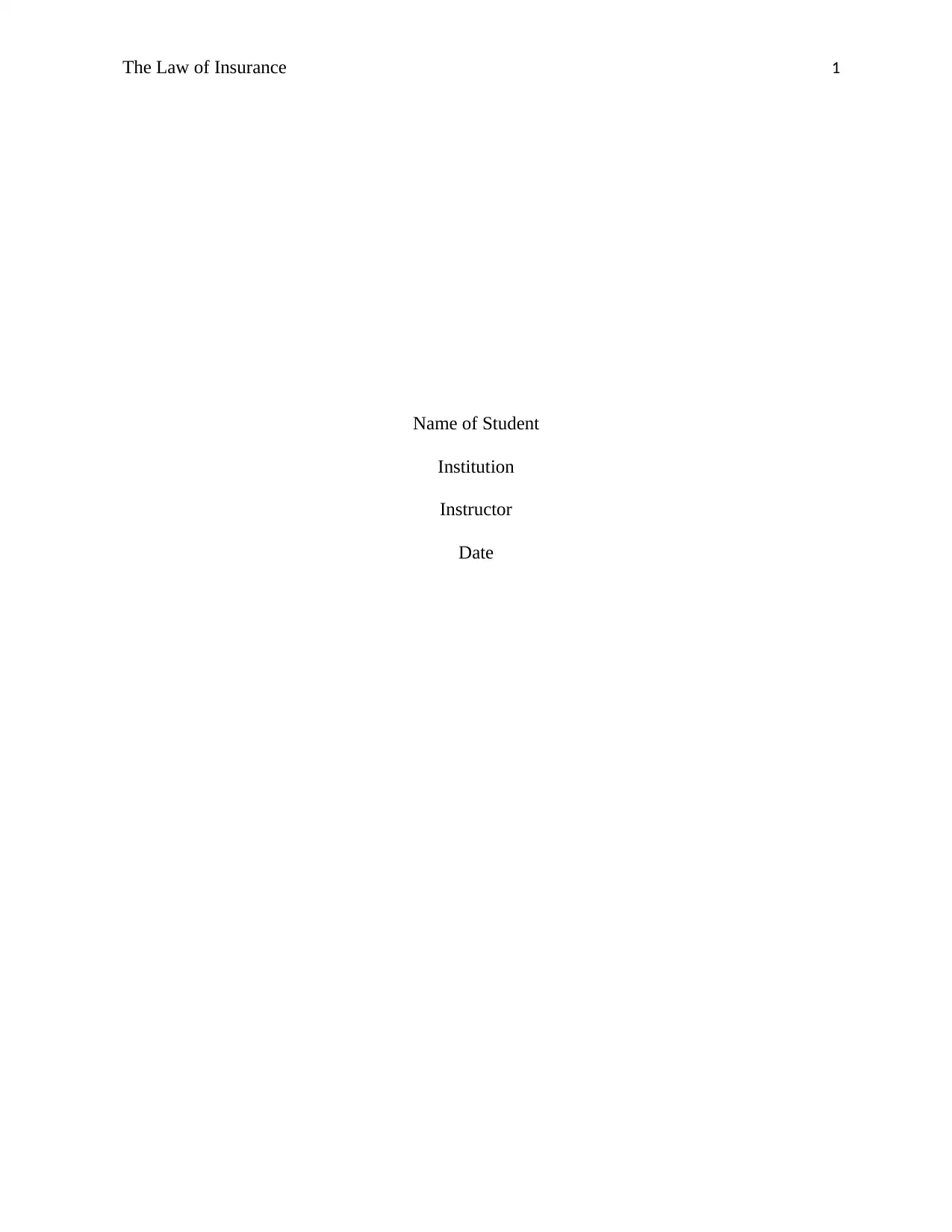
The Law of Insurance 1
Name of Student
Institution
Instructor
Date
Name of Student
Institution
Instructor
Date
Paraphrase This Document
Need a fresh take? Get an instant paraphrase of this document with our AI Paraphraser
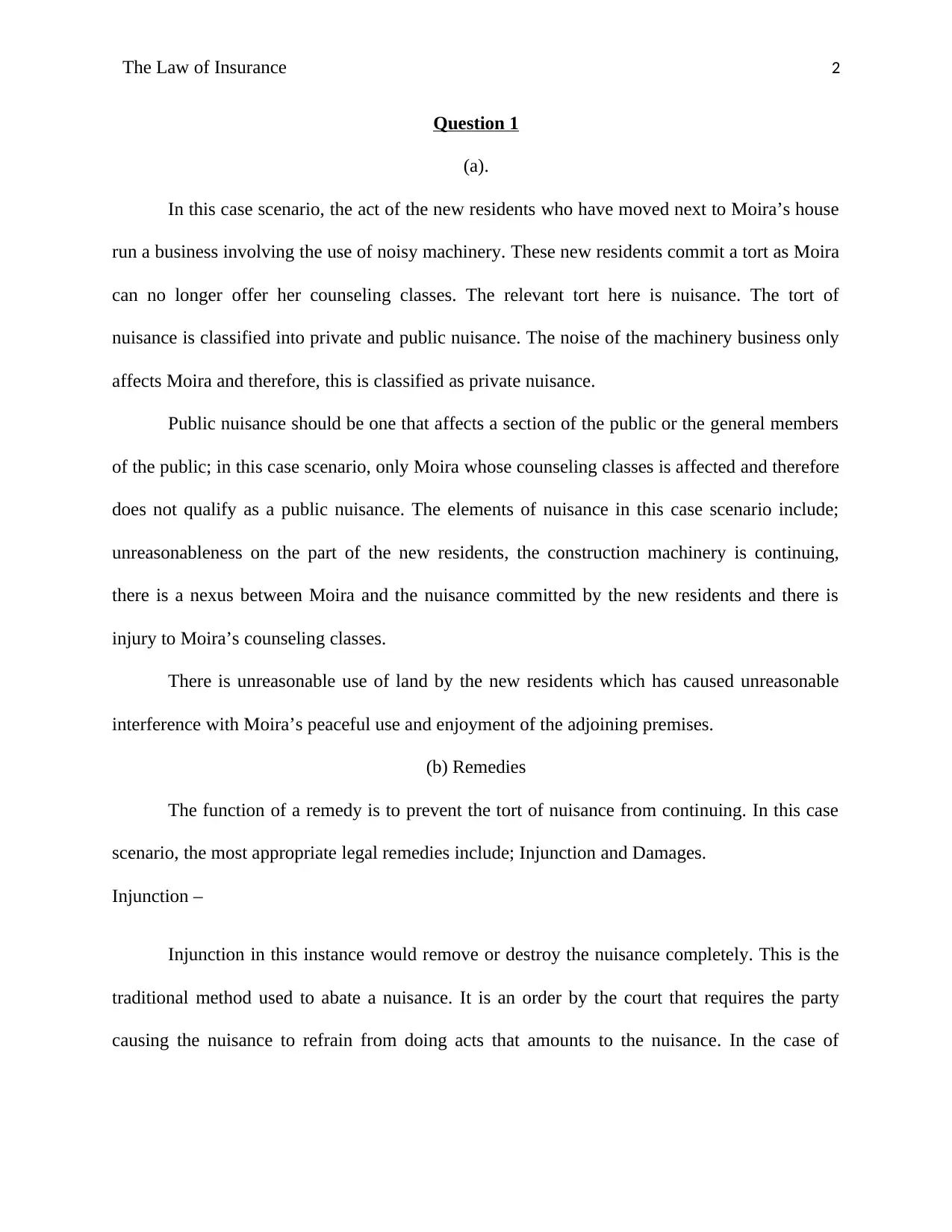
The Law of Insurance 2
Question 1
(a).
In this case scenario, the act of the new residents who have moved next to Moira’s house
run a business involving the use of noisy machinery. These new residents commit a tort as Moira
can no longer offer her counseling classes. The relevant tort here is nuisance. The tort of
nuisance is classified into private and public nuisance. The noise of the machinery business only
affects Moira and therefore, this is classified as private nuisance.
Public nuisance should be one that affects a section of the public or the general members
of the public; in this case scenario, only Moira whose counseling classes is affected and therefore
does not qualify as a public nuisance. The elements of nuisance in this case scenario include;
unreasonableness on the part of the new residents, the construction machinery is continuing,
there is a nexus between Moira and the nuisance committed by the new residents and there is
injury to Moira’s counseling classes.
There is unreasonable use of land by the new residents which has caused unreasonable
interference with Moira’s peaceful use and enjoyment of the adjoining premises.
(b) Remedies
The function of a remedy is to prevent the tort of nuisance from continuing. In this case
scenario, the most appropriate legal remedies include; Injunction and Damages.
Injunction –
Injunction in this instance would remove or destroy the nuisance completely. This is the
traditional method used to abate a nuisance. It is an order by the court that requires the party
causing the nuisance to refrain from doing acts that amounts to the nuisance. In the case of
Question 1
(a).
In this case scenario, the act of the new residents who have moved next to Moira’s house
run a business involving the use of noisy machinery. These new residents commit a tort as Moira
can no longer offer her counseling classes. The relevant tort here is nuisance. The tort of
nuisance is classified into private and public nuisance. The noise of the machinery business only
affects Moira and therefore, this is classified as private nuisance.
Public nuisance should be one that affects a section of the public or the general members
of the public; in this case scenario, only Moira whose counseling classes is affected and therefore
does not qualify as a public nuisance. The elements of nuisance in this case scenario include;
unreasonableness on the part of the new residents, the construction machinery is continuing,
there is a nexus between Moira and the nuisance committed by the new residents and there is
injury to Moira’s counseling classes.
There is unreasonable use of land by the new residents which has caused unreasonable
interference with Moira’s peaceful use and enjoyment of the adjoining premises.
(b) Remedies
The function of a remedy is to prevent the tort of nuisance from continuing. In this case
scenario, the most appropriate legal remedies include; Injunction and Damages.
Injunction –
Injunction in this instance would remove or destroy the nuisance completely. This is the
traditional method used to abate a nuisance. It is an order by the court that requires the party
causing the nuisance to refrain from doing acts that amounts to the nuisance. In the case of
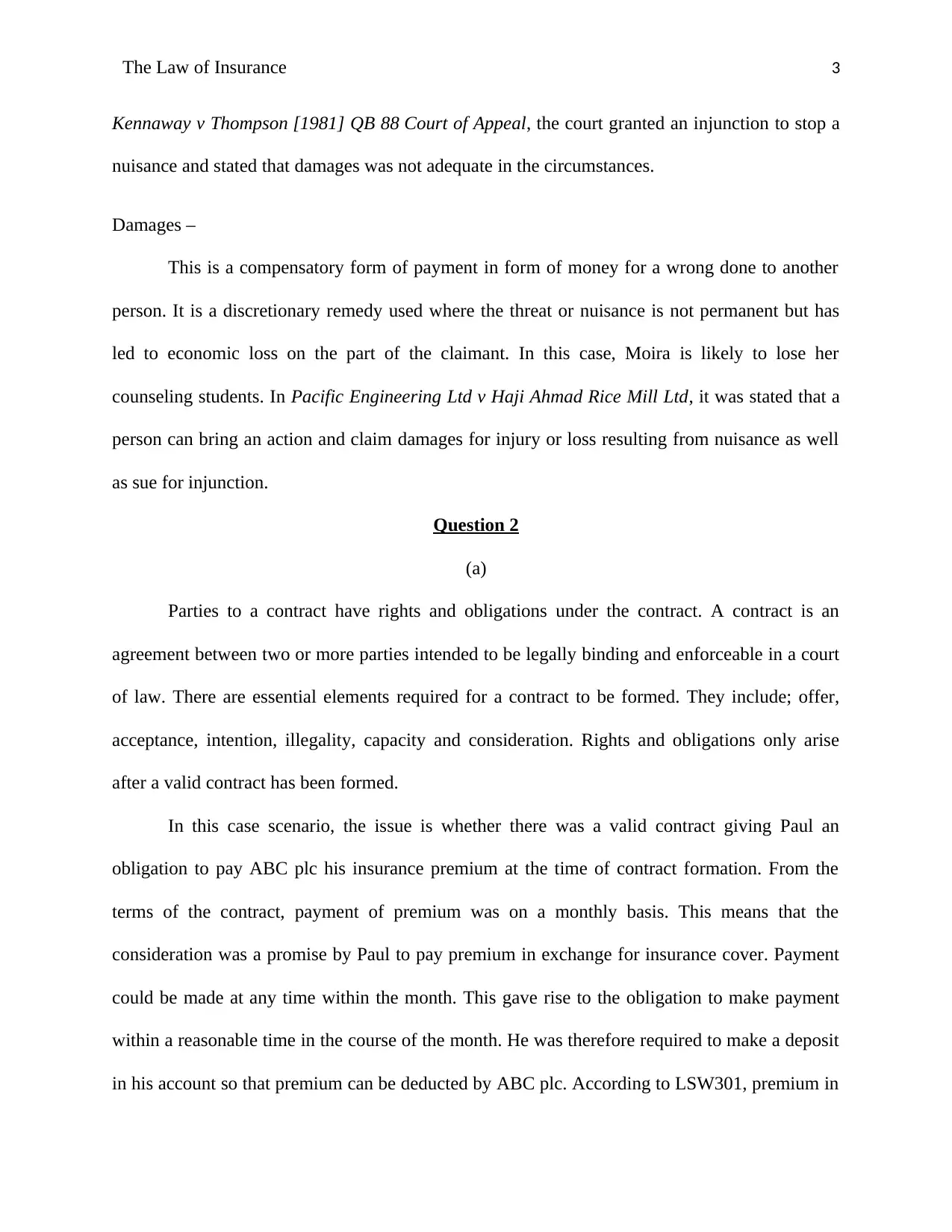
The Law of Insurance 3
Kennaway v Thompson [1981] QB 88 Court of Appeal, the court granted an injunction to stop a
nuisance and stated that damages was not adequate in the circumstances.
Damages –
This is a compensatory form of payment in form of money for a wrong done to another
person. It is a discretionary remedy used where the threat or nuisance is not permanent but has
led to economic loss on the part of the claimant. In this case, Moira is likely to lose her
counseling students. In Pacific Engineering Ltd v Haji Ahmad Rice Mill Ltd, it was stated that a
person can bring an action and claim damages for injury or loss resulting from nuisance as well
as sue for injunction.
Question 2
(a)
Parties to a contract have rights and obligations under the contract. A contract is an
agreement between two or more parties intended to be legally binding and enforceable in a court
of law. There are essential elements required for a contract to be formed. They include; offer,
acceptance, intention, illegality, capacity and consideration. Rights and obligations only arise
after a valid contract has been formed.
In this case scenario, the issue is whether there was a valid contract giving Paul an
obligation to pay ABC plc his insurance premium at the time of contract formation. From the
terms of the contract, payment of premium was on a monthly basis. This means that the
consideration was a promise by Paul to pay premium in exchange for insurance cover. Payment
could be made at any time within the month. This gave rise to the obligation to make payment
within a reasonable time in the course of the month. He was therefore required to make a deposit
in his account so that premium can be deducted by ABC plc. According to LSW301, premium in
Kennaway v Thompson [1981] QB 88 Court of Appeal, the court granted an injunction to stop a
nuisance and stated that damages was not adequate in the circumstances.
Damages –
This is a compensatory form of payment in form of money for a wrong done to another
person. It is a discretionary remedy used where the threat or nuisance is not permanent but has
led to economic loss on the part of the claimant. In this case, Moira is likely to lose her
counseling students. In Pacific Engineering Ltd v Haji Ahmad Rice Mill Ltd, it was stated that a
person can bring an action and claim damages for injury or loss resulting from nuisance as well
as sue for injunction.
Question 2
(a)
Parties to a contract have rights and obligations under the contract. A contract is an
agreement between two or more parties intended to be legally binding and enforceable in a court
of law. There are essential elements required for a contract to be formed. They include; offer,
acceptance, intention, illegality, capacity and consideration. Rights and obligations only arise
after a valid contract has been formed.
In this case scenario, the issue is whether there was a valid contract giving Paul an
obligation to pay ABC plc his insurance premium at the time of contract formation. From the
terms of the contract, payment of premium was on a monthly basis. This means that the
consideration was a promise by Paul to pay premium in exchange for insurance cover. Payment
could be made at any time within the month. This gave rise to the obligation to make payment
within a reasonable time in the course of the month. He was therefore required to make a deposit
in his account so that premium can be deducted by ABC plc. According to LSW301, premium in
⊘ This is a preview!⊘
Do you want full access?
Subscribe today to unlock all pages.

Trusted by 1+ million students worldwide
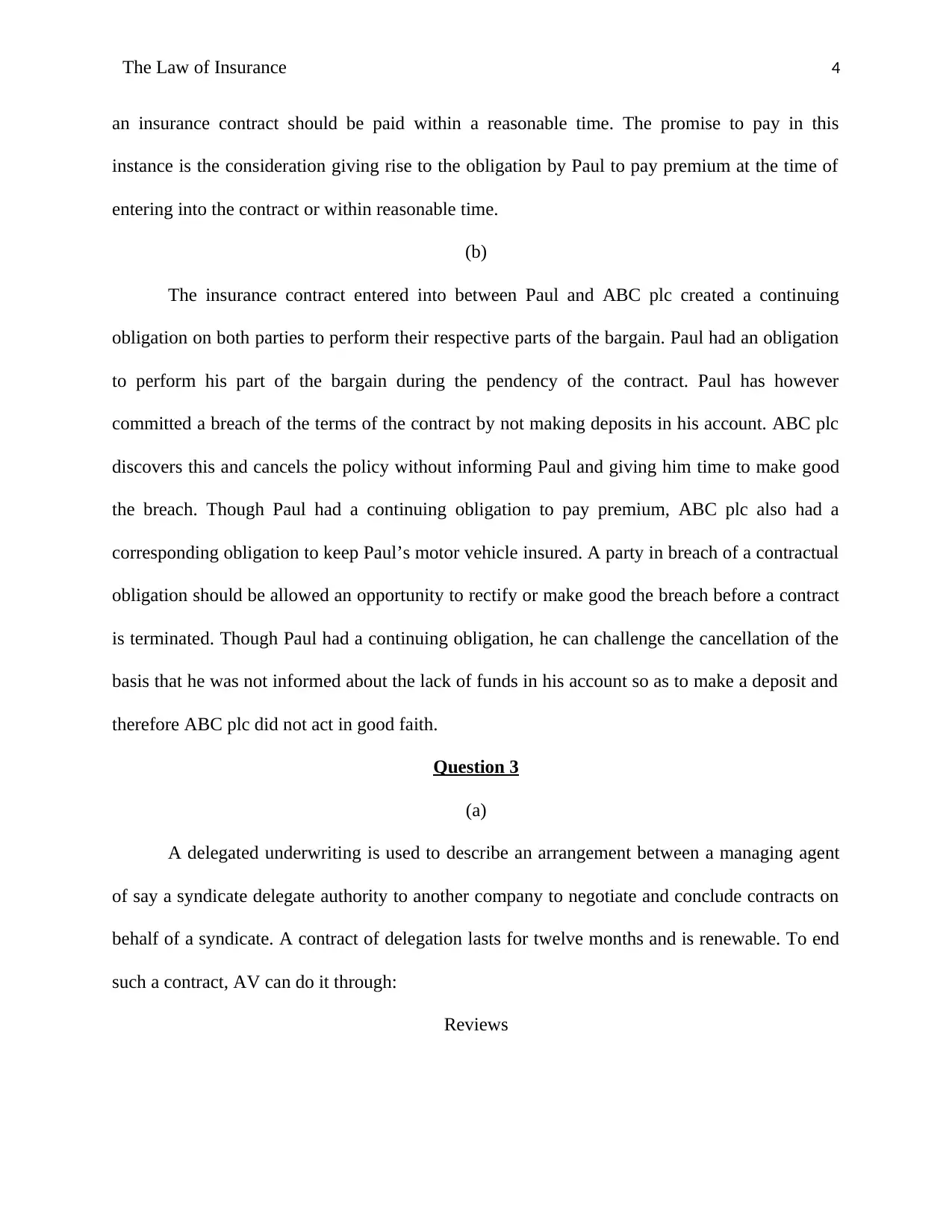
The Law of Insurance 4
an insurance contract should be paid within a reasonable time. The promise to pay in this
instance is the consideration giving rise to the obligation by Paul to pay premium at the time of
entering into the contract or within reasonable time.
(b)
The insurance contract entered into between Paul and ABC plc created a continuing
obligation on both parties to perform their respective parts of the bargain. Paul had an obligation
to perform his part of the bargain during the pendency of the contract. Paul has however
committed a breach of the terms of the contract by not making deposits in his account. ABC plc
discovers this and cancels the policy without informing Paul and giving him time to make good
the breach. Though Paul had a continuing obligation to pay premium, ABC plc also had a
corresponding obligation to keep Paul’s motor vehicle insured. A party in breach of a contractual
obligation should be allowed an opportunity to rectify or make good the breach before a contract
is terminated. Though Paul had a continuing obligation, he can challenge the cancellation of the
basis that he was not informed about the lack of funds in his account so as to make a deposit and
therefore ABC plc did not act in good faith.
Question 3
(a)
A delegated underwriting is used to describe an arrangement between a managing agent
of say a syndicate delegate authority to another company to negotiate and conclude contracts on
behalf of a syndicate. A contract of delegation lasts for twelve months and is renewable. To end
such a contract, AV can do it through:
Reviews
an insurance contract should be paid within a reasonable time. The promise to pay in this
instance is the consideration giving rise to the obligation by Paul to pay premium at the time of
entering into the contract or within reasonable time.
(b)
The insurance contract entered into between Paul and ABC plc created a continuing
obligation on both parties to perform their respective parts of the bargain. Paul had an obligation
to perform his part of the bargain during the pendency of the contract. Paul has however
committed a breach of the terms of the contract by not making deposits in his account. ABC plc
discovers this and cancels the policy without informing Paul and giving him time to make good
the breach. Though Paul had a continuing obligation to pay premium, ABC plc also had a
corresponding obligation to keep Paul’s motor vehicle insured. A party in breach of a contractual
obligation should be allowed an opportunity to rectify or make good the breach before a contract
is terminated. Though Paul had a continuing obligation, he can challenge the cancellation of the
basis that he was not informed about the lack of funds in his account so as to make a deposit and
therefore ABC plc did not act in good faith.
Question 3
(a)
A delegated underwriting is used to describe an arrangement between a managing agent
of say a syndicate delegate authority to another company to negotiate and conclude contracts on
behalf of a syndicate. A contract of delegation lasts for twelve months and is renewable. To end
such a contract, AV can do it through:
Reviews
Paraphrase This Document
Need a fresh take? Get an instant paraphrase of this document with our AI Paraphraser
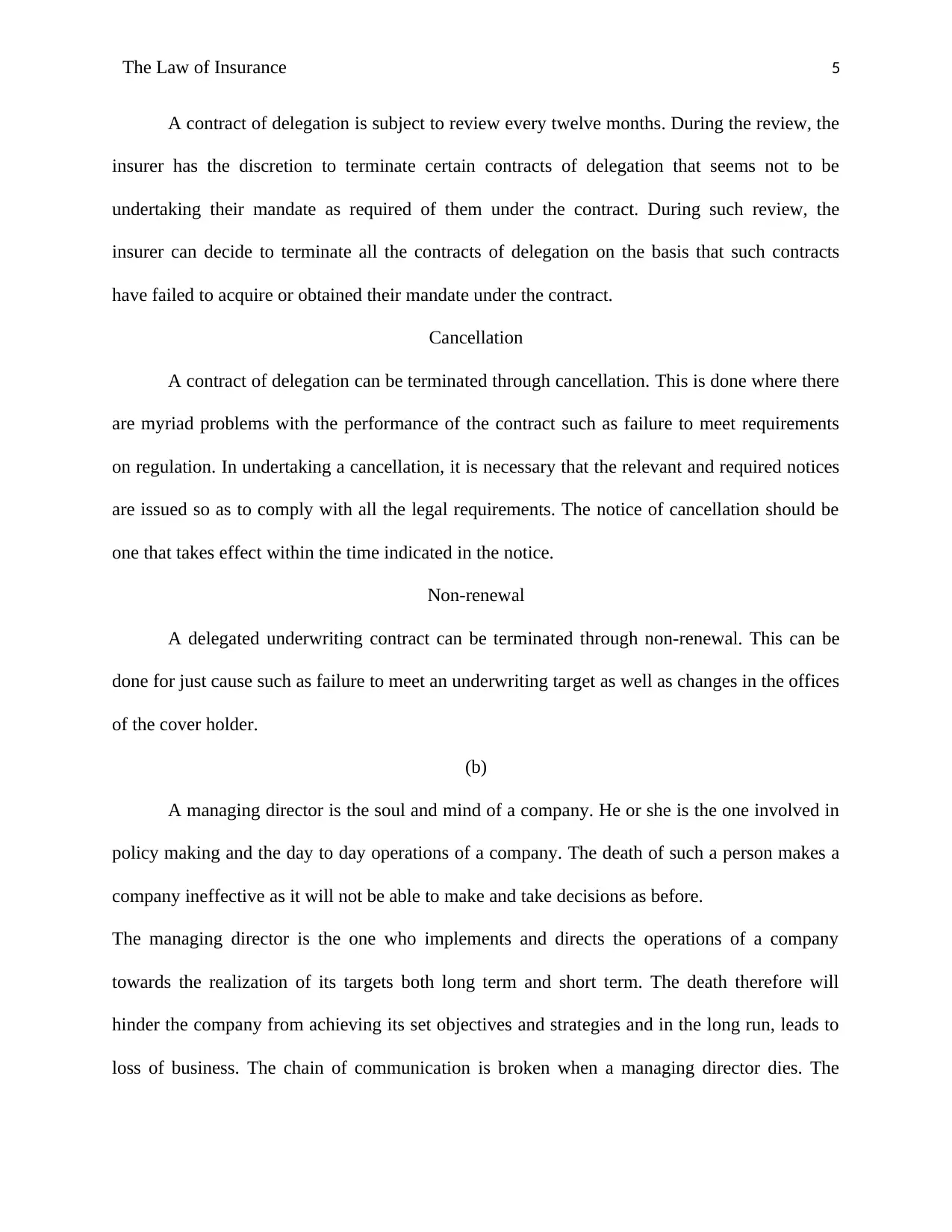
The Law of Insurance 5
A contract of delegation is subject to review every twelve months. During the review, the
insurer has the discretion to terminate certain contracts of delegation that seems not to be
undertaking their mandate as required of them under the contract. During such review, the
insurer can decide to terminate all the contracts of delegation on the basis that such contracts
have failed to acquire or obtained their mandate under the contract.
Cancellation
A contract of delegation can be terminated through cancellation. This is done where there
are myriad problems with the performance of the contract such as failure to meet requirements
on regulation. In undertaking a cancellation, it is necessary that the relevant and required notices
are issued so as to comply with all the legal requirements. The notice of cancellation should be
one that takes effect within the time indicated in the notice.
Non-renewal
A delegated underwriting contract can be terminated through non-renewal. This can be
done for just cause such as failure to meet an underwriting target as well as changes in the offices
of the cover holder.
(b)
A managing director is the soul and mind of a company. He or she is the one involved in
policy making and the day to day operations of a company. The death of such a person makes a
company ineffective as it will not be able to make and take decisions as before.
The managing director is the one who implements and directs the operations of a company
towards the realization of its targets both long term and short term. The death therefore will
hinder the company from achieving its set objectives and strategies and in the long run, leads to
loss of business. The chain of communication is broken when a managing director dies. The
A contract of delegation is subject to review every twelve months. During the review, the
insurer has the discretion to terminate certain contracts of delegation that seems not to be
undertaking their mandate as required of them under the contract. During such review, the
insurer can decide to terminate all the contracts of delegation on the basis that such contracts
have failed to acquire or obtained their mandate under the contract.
Cancellation
A contract of delegation can be terminated through cancellation. This is done where there
are myriad problems with the performance of the contract such as failure to meet requirements
on regulation. In undertaking a cancellation, it is necessary that the relevant and required notices
are issued so as to comply with all the legal requirements. The notice of cancellation should be
one that takes effect within the time indicated in the notice.
Non-renewal
A delegated underwriting contract can be terminated through non-renewal. This can be
done for just cause such as failure to meet an underwriting target as well as changes in the offices
of the cover holder.
(b)
A managing director is the soul and mind of a company. He or she is the one involved in
policy making and the day to day operations of a company. The death of such a person makes a
company ineffective as it will not be able to make and take decisions as before.
The managing director is the one who implements and directs the operations of a company
towards the realization of its targets both long term and short term. The death therefore will
hinder the company from achieving its set objectives and strategies and in the long run, leads to
loss of business. The chain of communication is broken when a managing director dies. The
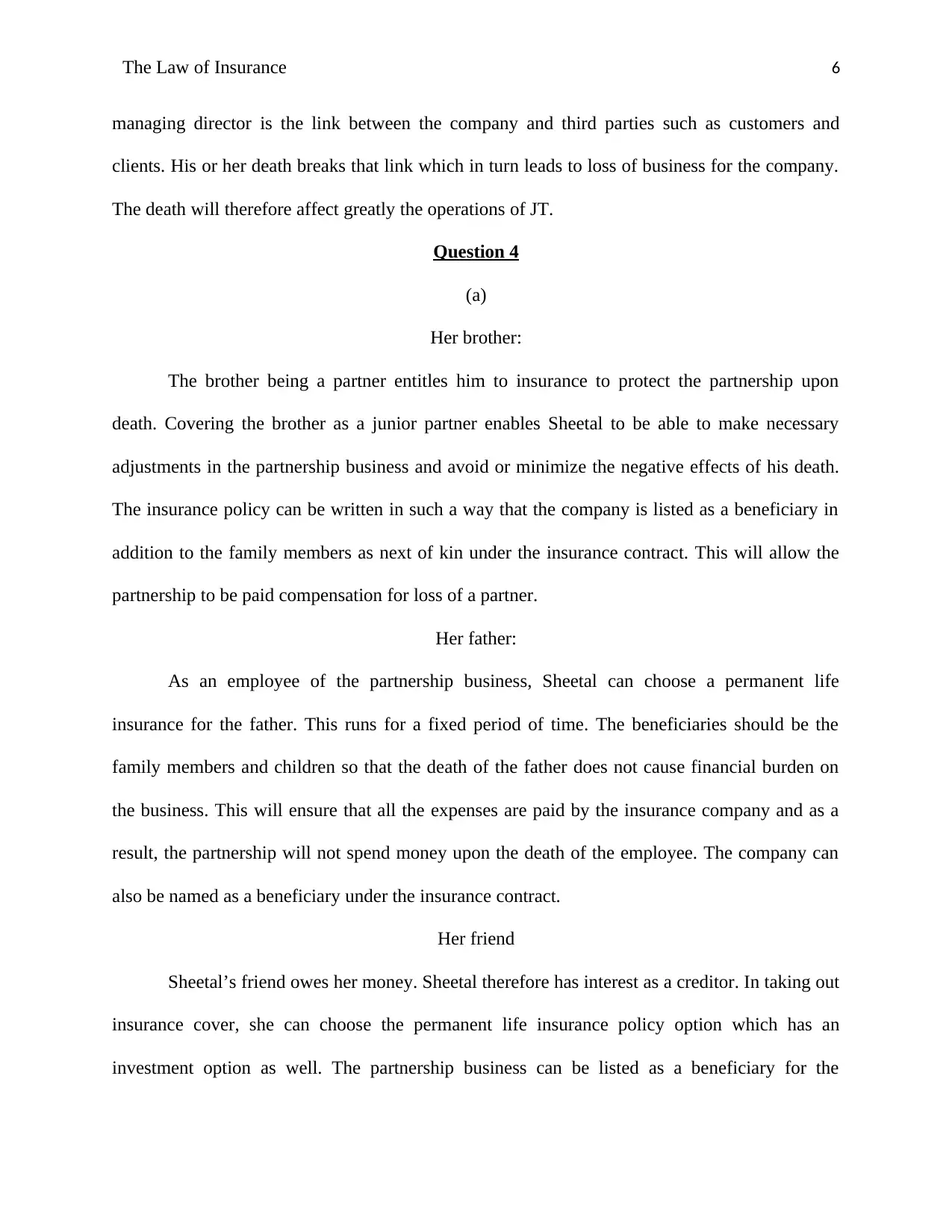
The Law of Insurance 6
managing director is the link between the company and third parties such as customers and
clients. His or her death breaks that link which in turn leads to loss of business for the company.
The death will therefore affect greatly the operations of JT.
Question 4
(a)
Her brother:
The brother being a partner entitles him to insurance to protect the partnership upon
death. Covering the brother as a junior partner enables Sheetal to be able to make necessary
adjustments in the partnership business and avoid or minimize the negative effects of his death.
The insurance policy can be written in such a way that the company is listed as a beneficiary in
addition to the family members as next of kin under the insurance contract. This will allow the
partnership to be paid compensation for loss of a partner.
Her father:
As an employee of the partnership business, Sheetal can choose a permanent life
insurance for the father. This runs for a fixed period of time. The beneficiaries should be the
family members and children so that the death of the father does not cause financial burden on
the business. This will ensure that all the expenses are paid by the insurance company and as a
result, the partnership will not spend money upon the death of the employee. The company can
also be named as a beneficiary under the insurance contract.
Her friend
Sheetal’s friend owes her money. Sheetal therefore has interest as a creditor. In taking out
insurance cover, she can choose the permanent life insurance policy option which has an
investment option as well. The partnership business can be listed as a beneficiary for the
managing director is the link between the company and third parties such as customers and
clients. His or her death breaks that link which in turn leads to loss of business for the company.
The death will therefore affect greatly the operations of JT.
Question 4
(a)
Her brother:
The brother being a partner entitles him to insurance to protect the partnership upon
death. Covering the brother as a junior partner enables Sheetal to be able to make necessary
adjustments in the partnership business and avoid or minimize the negative effects of his death.
The insurance policy can be written in such a way that the company is listed as a beneficiary in
addition to the family members as next of kin under the insurance contract. This will allow the
partnership to be paid compensation for loss of a partner.
Her father:
As an employee of the partnership business, Sheetal can choose a permanent life
insurance for the father. This runs for a fixed period of time. The beneficiaries should be the
family members and children so that the death of the father does not cause financial burden on
the business. This will ensure that all the expenses are paid by the insurance company and as a
result, the partnership will not spend money upon the death of the employee. The company can
also be named as a beneficiary under the insurance contract.
Her friend
Sheetal’s friend owes her money. Sheetal therefore has interest as a creditor. In taking out
insurance cover, she can choose the permanent life insurance policy option which has an
investment option as well. The partnership business can be listed as a beneficiary for the
⊘ This is a preview!⊘
Do you want full access?
Subscribe today to unlock all pages.

Trusted by 1+ million students worldwide
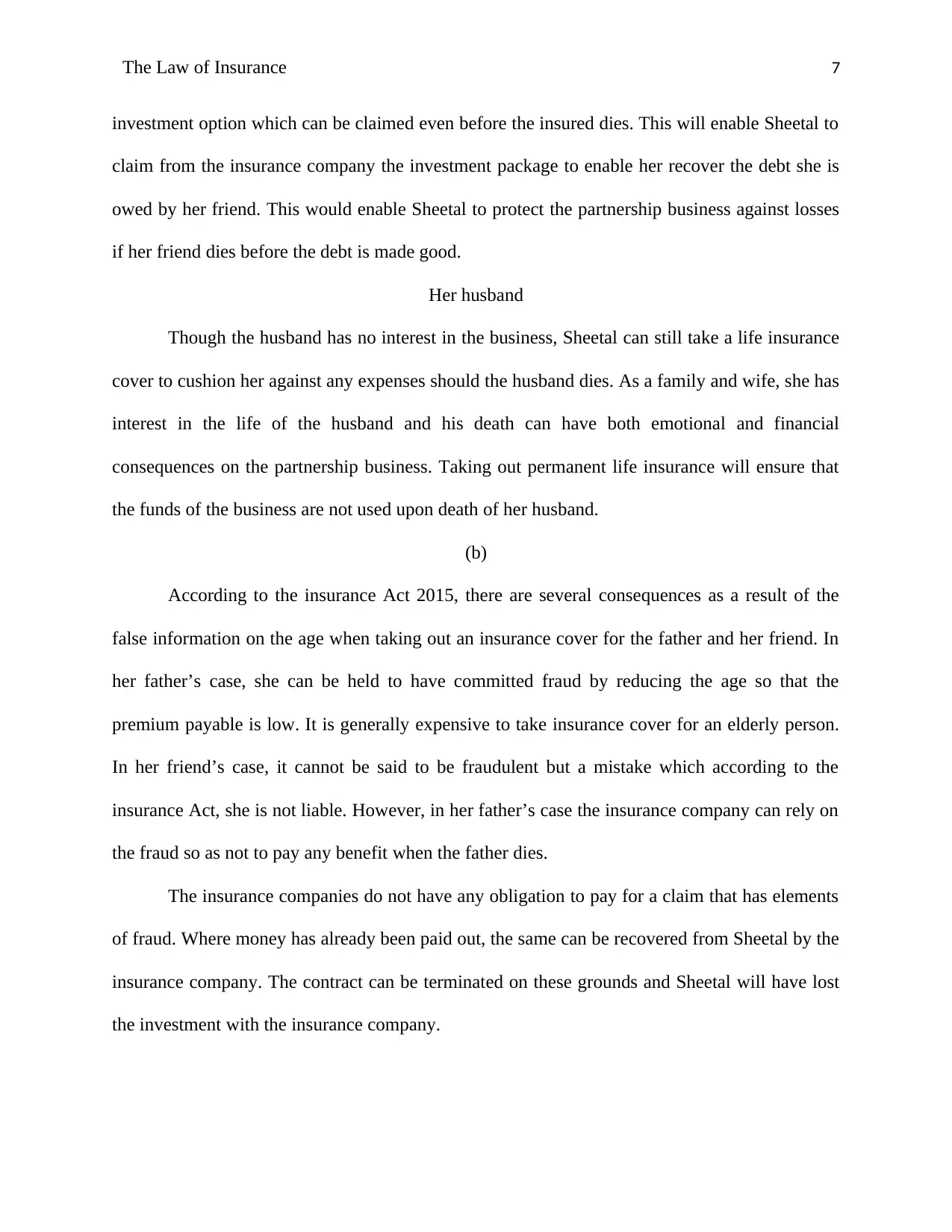
The Law of Insurance 7
investment option which can be claimed even before the insured dies. This will enable Sheetal to
claim from the insurance company the investment package to enable her recover the debt she is
owed by her friend. This would enable Sheetal to protect the partnership business against losses
if her friend dies before the debt is made good.
Her husband
Though the husband has no interest in the business, Sheetal can still take a life insurance
cover to cushion her against any expenses should the husband dies. As a family and wife, she has
interest in the life of the husband and his death can have both emotional and financial
consequences on the partnership business. Taking out permanent life insurance will ensure that
the funds of the business are not used upon death of her husband.
(b)
According to the insurance Act 2015, there are several consequences as a result of the
false information on the age when taking out an insurance cover for the father and her friend. In
her father’s case, she can be held to have committed fraud by reducing the age so that the
premium payable is low. It is generally expensive to take insurance cover for an elderly person.
In her friend’s case, it cannot be said to be fraudulent but a mistake which according to the
insurance Act, she is not liable. However, in her father’s case the insurance company can rely on
the fraud so as not to pay any benefit when the father dies.
The insurance companies do not have any obligation to pay for a claim that has elements
of fraud. Where money has already been paid out, the same can be recovered from Sheetal by the
insurance company. The contract can be terminated on these grounds and Sheetal will have lost
the investment with the insurance company.
investment option which can be claimed even before the insured dies. This will enable Sheetal to
claim from the insurance company the investment package to enable her recover the debt she is
owed by her friend. This would enable Sheetal to protect the partnership business against losses
if her friend dies before the debt is made good.
Her husband
Though the husband has no interest in the business, Sheetal can still take a life insurance
cover to cushion her against any expenses should the husband dies. As a family and wife, she has
interest in the life of the husband and his death can have both emotional and financial
consequences on the partnership business. Taking out permanent life insurance will ensure that
the funds of the business are not used upon death of her husband.
(b)
According to the insurance Act 2015, there are several consequences as a result of the
false information on the age when taking out an insurance cover for the father and her friend. In
her father’s case, she can be held to have committed fraud by reducing the age so that the
premium payable is low. It is generally expensive to take insurance cover for an elderly person.
In her friend’s case, it cannot be said to be fraudulent but a mistake which according to the
insurance Act, she is not liable. However, in her father’s case the insurance company can rely on
the fraud so as not to pay any benefit when the father dies.
The insurance companies do not have any obligation to pay for a claim that has elements
of fraud. Where money has already been paid out, the same can be recovered from Sheetal by the
insurance company. The contract can be terminated on these grounds and Sheetal will have lost
the investment with the insurance company.
Paraphrase This Document
Need a fresh take? Get an instant paraphrase of this document with our AI Paraphraser
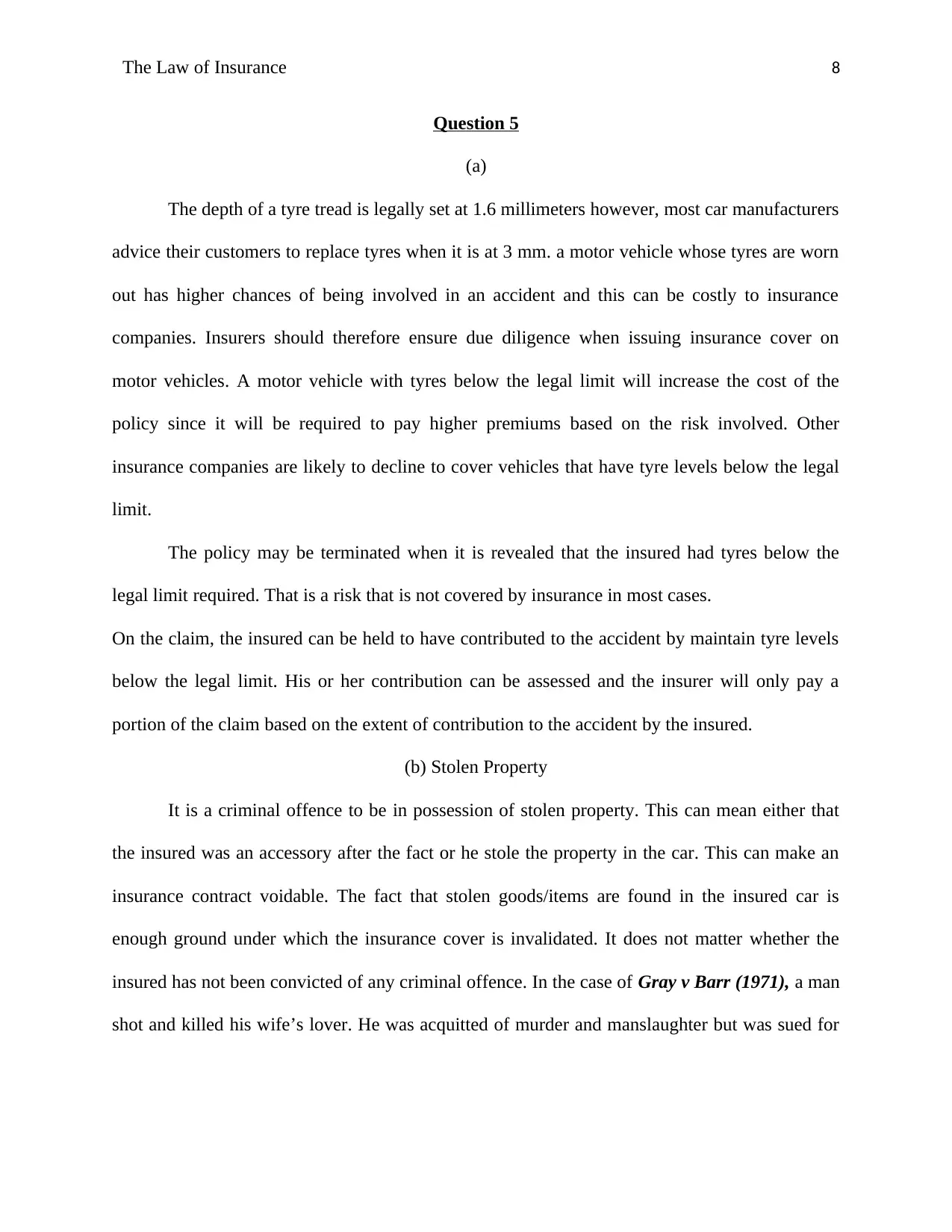
The Law of Insurance 8
Question 5
(a)
The depth of a tyre tread is legally set at 1.6 millimeters however, most car manufacturers
advice their customers to replace tyres when it is at 3 mm. a motor vehicle whose tyres are worn
out has higher chances of being involved in an accident and this can be costly to insurance
companies. Insurers should therefore ensure due diligence when issuing insurance cover on
motor vehicles. A motor vehicle with tyres below the legal limit will increase the cost of the
policy since it will be required to pay higher premiums based on the risk involved. Other
insurance companies are likely to decline to cover vehicles that have tyre levels below the legal
limit.
The policy may be terminated when it is revealed that the insured had tyres below the
legal limit required. That is a risk that is not covered by insurance in most cases.
On the claim, the insured can be held to have contributed to the accident by maintain tyre levels
below the legal limit. His or her contribution can be assessed and the insurer will only pay a
portion of the claim based on the extent of contribution to the accident by the insured.
(b) Stolen Property
It is a criminal offence to be in possession of stolen property. This can mean either that
the insured was an accessory after the fact or he stole the property in the car. This can make an
insurance contract voidable. The fact that stolen goods/items are found in the insured car is
enough ground under which the insurance cover is invalidated. It does not matter whether the
insured has not been convicted of any criminal offence. In the case of Gray v Barr (1971), a man
shot and killed his wife’s lover. He was acquitted of murder and manslaughter but was sued for
Question 5
(a)
The depth of a tyre tread is legally set at 1.6 millimeters however, most car manufacturers
advice their customers to replace tyres when it is at 3 mm. a motor vehicle whose tyres are worn
out has higher chances of being involved in an accident and this can be costly to insurance
companies. Insurers should therefore ensure due diligence when issuing insurance cover on
motor vehicles. A motor vehicle with tyres below the legal limit will increase the cost of the
policy since it will be required to pay higher premiums based on the risk involved. Other
insurance companies are likely to decline to cover vehicles that have tyre levels below the legal
limit.
The policy may be terminated when it is revealed that the insured had tyres below the
legal limit required. That is a risk that is not covered by insurance in most cases.
On the claim, the insured can be held to have contributed to the accident by maintain tyre levels
below the legal limit. His or her contribution can be assessed and the insurer will only pay a
portion of the claim based on the extent of contribution to the accident by the insured.
(b) Stolen Property
It is a criminal offence to be in possession of stolen property. This can mean either that
the insured was an accessory after the fact or he stole the property in the car. This can make an
insurance contract voidable. The fact that stolen goods/items are found in the insured car is
enough ground under which the insurance cover is invalidated. It does not matter whether the
insured has not been convicted of any criminal offence. In the case of Gray v Barr (1971), a man
shot and killed his wife’s lover. He was acquitted of murder and manslaughter but was sued for
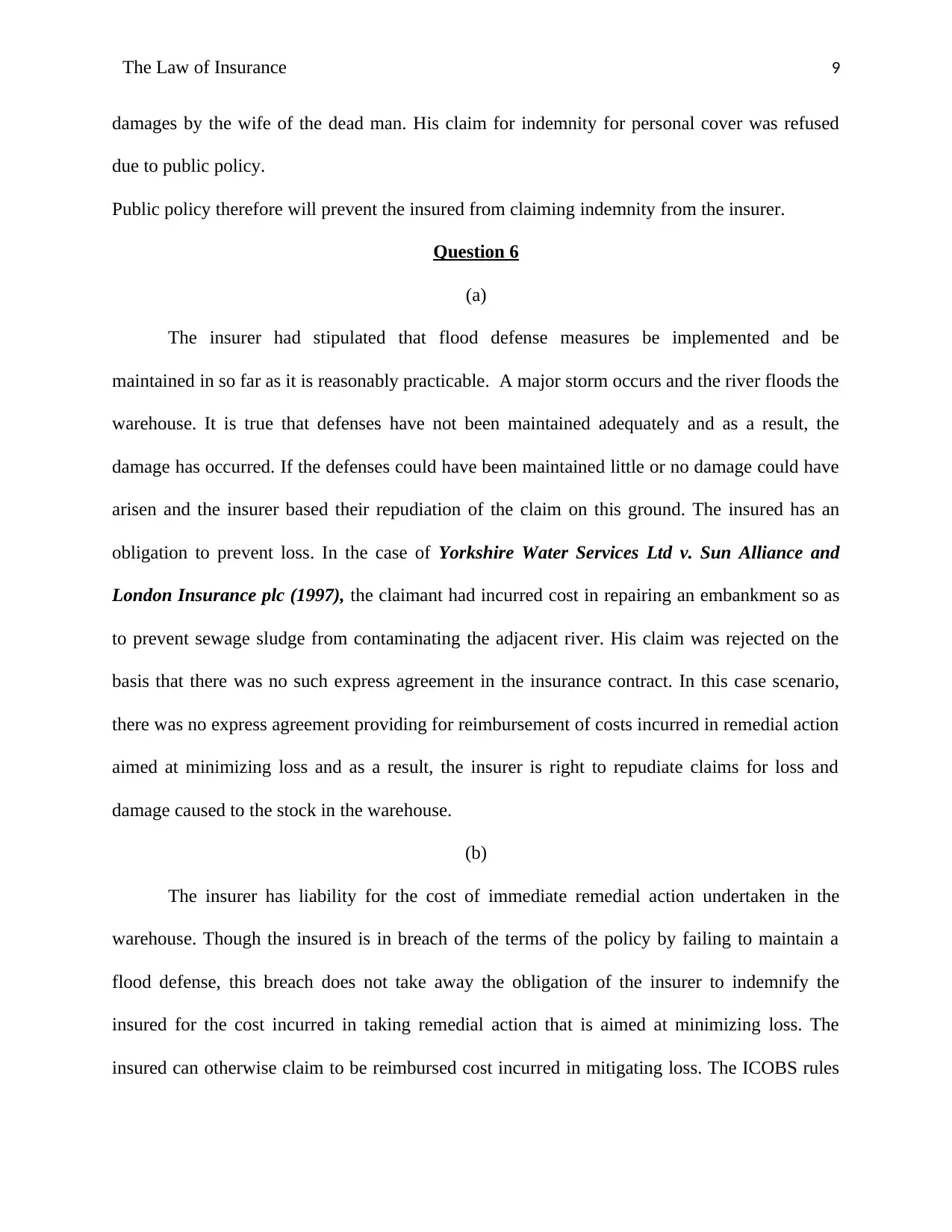
The Law of Insurance 9
damages by the wife of the dead man. His claim for indemnity for personal cover was refused
due to public policy.
Public policy therefore will prevent the insured from claiming indemnity from the insurer.
Question 6
(a)
The insurer had stipulated that flood defense measures be implemented and be
maintained in so far as it is reasonably practicable. A major storm occurs and the river floods the
warehouse. It is true that defenses have not been maintained adequately and as a result, the
damage has occurred. If the defenses could have been maintained little or no damage could have
arisen and the insurer based their repudiation of the claim on this ground. The insured has an
obligation to prevent loss. In the case of Yorkshire Water Services Ltd v. Sun Alliance and
London Insurance plc (1997), the claimant had incurred cost in repairing an embankment so as
to prevent sewage sludge from contaminating the adjacent river. His claim was rejected on the
basis that there was no such express agreement in the insurance contract. In this case scenario,
there was no express agreement providing for reimbursement of costs incurred in remedial action
aimed at minimizing loss and as a result, the insurer is right to repudiate claims for loss and
damage caused to the stock in the warehouse.
(b)
The insurer has liability for the cost of immediate remedial action undertaken in the
warehouse. Though the insured is in breach of the terms of the policy by failing to maintain a
flood defense, this breach does not take away the obligation of the insurer to indemnify the
insured for the cost incurred in taking remedial action that is aimed at minimizing loss. The
insured can otherwise claim to be reimbursed cost incurred in mitigating loss. The ICOBS rules
damages by the wife of the dead man. His claim for indemnity for personal cover was refused
due to public policy.
Public policy therefore will prevent the insured from claiming indemnity from the insurer.
Question 6
(a)
The insurer had stipulated that flood defense measures be implemented and be
maintained in so far as it is reasonably practicable. A major storm occurs and the river floods the
warehouse. It is true that defenses have not been maintained adequately and as a result, the
damage has occurred. If the defenses could have been maintained little or no damage could have
arisen and the insurer based their repudiation of the claim on this ground. The insured has an
obligation to prevent loss. In the case of Yorkshire Water Services Ltd v. Sun Alliance and
London Insurance plc (1997), the claimant had incurred cost in repairing an embankment so as
to prevent sewage sludge from contaminating the adjacent river. His claim was rejected on the
basis that there was no such express agreement in the insurance contract. In this case scenario,
there was no express agreement providing for reimbursement of costs incurred in remedial action
aimed at minimizing loss and as a result, the insurer is right to repudiate claims for loss and
damage caused to the stock in the warehouse.
(b)
The insurer has liability for the cost of immediate remedial action undertaken in the
warehouse. Though the insured is in breach of the terms of the policy by failing to maintain a
flood defense, this breach does not take away the obligation of the insurer to indemnify the
insured for the cost incurred in taking remedial action that is aimed at minimizing loss. The
insured can otherwise claim to be reimbursed cost incurred in mitigating loss. The ICOBS rules
⊘ This is a preview!⊘
Do you want full access?
Subscribe today to unlock all pages.

Trusted by 1+ million students worldwide
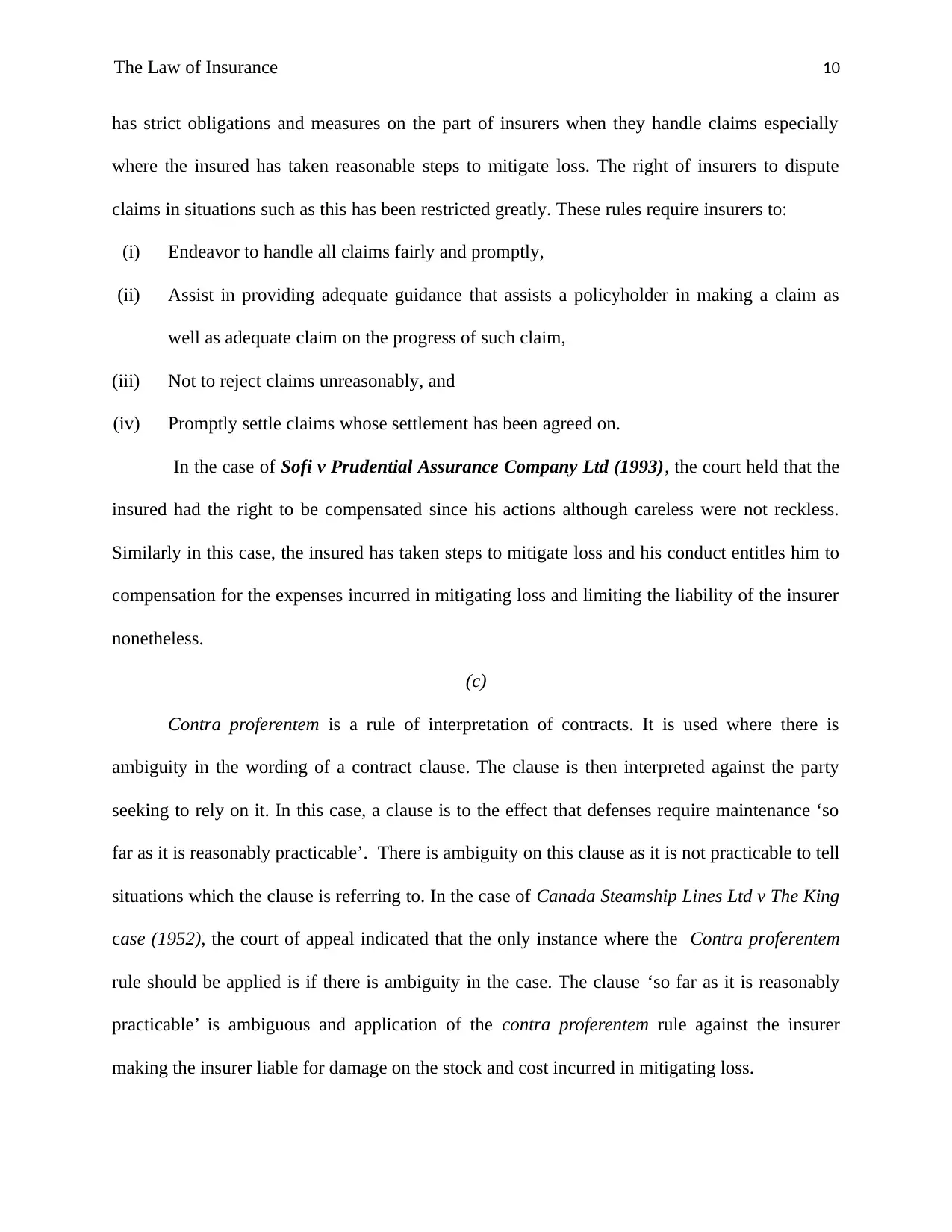
The Law of Insurance 10
has strict obligations and measures on the part of insurers when they handle claims especially
where the insured has taken reasonable steps to mitigate loss. The right of insurers to dispute
claims in situations such as this has been restricted greatly. These rules require insurers to:
(i) Endeavor to handle all claims fairly and promptly,
(ii) Assist in providing adequate guidance that assists a policyholder in making a claim as
well as adequate claim on the progress of such claim,
(iii) Not to reject claims unreasonably, and
(iv) Promptly settle claims whose settlement has been agreed on.
In the case of Sofi v Prudential Assurance Company Ltd (1993), the court held that the
insured had the right to be compensated since his actions although careless were not reckless.
Similarly in this case, the insured has taken steps to mitigate loss and his conduct entitles him to
compensation for the expenses incurred in mitigating loss and limiting the liability of the insurer
nonetheless.
(c)
Contra proferentem is a rule of interpretation of contracts. It is used where there is
ambiguity in the wording of a contract clause. The clause is then interpreted against the party
seeking to rely on it. In this case, a clause is to the effect that defenses require maintenance ‘so
far as it is reasonably practicable’. There is ambiguity on this clause as it is not practicable to tell
situations which the clause is referring to. In the case of Canada Steamship Lines Ltd v The King
case (1952), the court of appeal indicated that the only instance where the Contra proferentem
rule should be applied is if there is ambiguity in the case. The clause ‘so far as it is reasonably
practicable’ is ambiguous and application of the contra proferentem rule against the insurer
making the insurer liable for damage on the stock and cost incurred in mitigating loss.
has strict obligations and measures on the part of insurers when they handle claims especially
where the insured has taken reasonable steps to mitigate loss. The right of insurers to dispute
claims in situations such as this has been restricted greatly. These rules require insurers to:
(i) Endeavor to handle all claims fairly and promptly,
(ii) Assist in providing adequate guidance that assists a policyholder in making a claim as
well as adequate claim on the progress of such claim,
(iii) Not to reject claims unreasonably, and
(iv) Promptly settle claims whose settlement has been agreed on.
In the case of Sofi v Prudential Assurance Company Ltd (1993), the court held that the
insured had the right to be compensated since his actions although careless were not reckless.
Similarly in this case, the insured has taken steps to mitigate loss and his conduct entitles him to
compensation for the expenses incurred in mitigating loss and limiting the liability of the insurer
nonetheless.
(c)
Contra proferentem is a rule of interpretation of contracts. It is used where there is
ambiguity in the wording of a contract clause. The clause is then interpreted against the party
seeking to rely on it. In this case, a clause is to the effect that defenses require maintenance ‘so
far as it is reasonably practicable’. There is ambiguity on this clause as it is not practicable to tell
situations which the clause is referring to. In the case of Canada Steamship Lines Ltd v The King
case (1952), the court of appeal indicated that the only instance where the Contra proferentem
rule should be applied is if there is ambiguity in the case. The clause ‘so far as it is reasonably
practicable’ is ambiguous and application of the contra proferentem rule against the insurer
making the insurer liable for damage on the stock and cost incurred in mitigating loss.
Paraphrase This Document
Need a fresh take? Get an instant paraphrase of this document with our AI Paraphraser
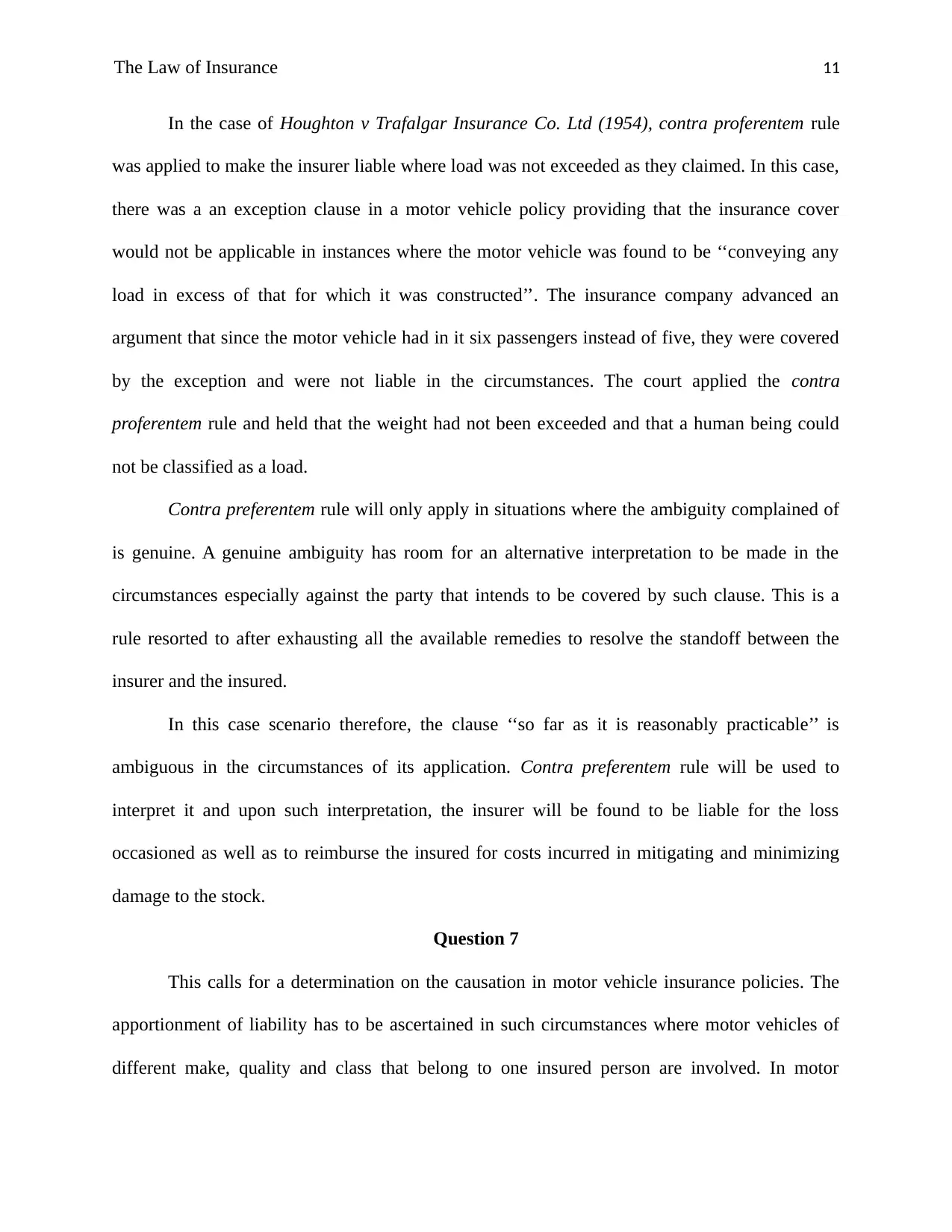
The Law of Insurance 11
In the case of Houghton v Trafalgar Insurance Co. Ltd (1954), contra proferentem rule
was applied to make the insurer liable where load was not exceeded as they claimed. In this case,
there was a an exception clause in a motor vehicle policy providing that the insurance cover
would not be applicable in instances where the motor vehicle was found to be ‘‘conveying any
load in excess of that for which it was constructed’’. The insurance company advanced an
argument that since the motor vehicle had in it six passengers instead of five, they were covered
by the exception and were not liable in the circumstances. The court applied the contra
proferentem rule and held that the weight had not been exceeded and that a human being could
not be classified as a load.
Contra preferentem rule will only apply in situations where the ambiguity complained of
is genuine. A genuine ambiguity has room for an alternative interpretation to be made in the
circumstances especially against the party that intends to be covered by such clause. This is a
rule resorted to after exhausting all the available remedies to resolve the standoff between the
insurer and the insured.
In this case scenario therefore, the clause ‘‘so far as it is reasonably practicable’’ is
ambiguous in the circumstances of its application. Contra preferentem rule will be used to
interpret it and upon such interpretation, the insurer will be found to be liable for the loss
occasioned as well as to reimburse the insured for costs incurred in mitigating and minimizing
damage to the stock.
Question 7
This calls for a determination on the causation in motor vehicle insurance policies. The
apportionment of liability has to be ascertained in such circumstances where motor vehicles of
different make, quality and class that belong to one insured person are involved. In motor
In the case of Houghton v Trafalgar Insurance Co. Ltd (1954), contra proferentem rule
was applied to make the insurer liable where load was not exceeded as they claimed. In this case,
there was a an exception clause in a motor vehicle policy providing that the insurance cover
would not be applicable in instances where the motor vehicle was found to be ‘‘conveying any
load in excess of that for which it was constructed’’. The insurance company advanced an
argument that since the motor vehicle had in it six passengers instead of five, they were covered
by the exception and were not liable in the circumstances. The court applied the contra
proferentem rule and held that the weight had not been exceeded and that a human being could
not be classified as a load.
Contra preferentem rule will only apply in situations where the ambiguity complained of
is genuine. A genuine ambiguity has room for an alternative interpretation to be made in the
circumstances especially against the party that intends to be covered by such clause. This is a
rule resorted to after exhausting all the available remedies to resolve the standoff between the
insurer and the insured.
In this case scenario therefore, the clause ‘‘so far as it is reasonably practicable’’ is
ambiguous in the circumstances of its application. Contra preferentem rule will be used to
interpret it and upon such interpretation, the insurer will be found to be liable for the loss
occasioned as well as to reimburse the insured for costs incurred in mitigating and minimizing
damage to the stock.
Question 7
This calls for a determination on the causation in motor vehicle insurance policies. The
apportionment of liability has to be ascertained in such circumstances where motor vehicles of
different make, quality and class that belong to one insured person are involved. In motor
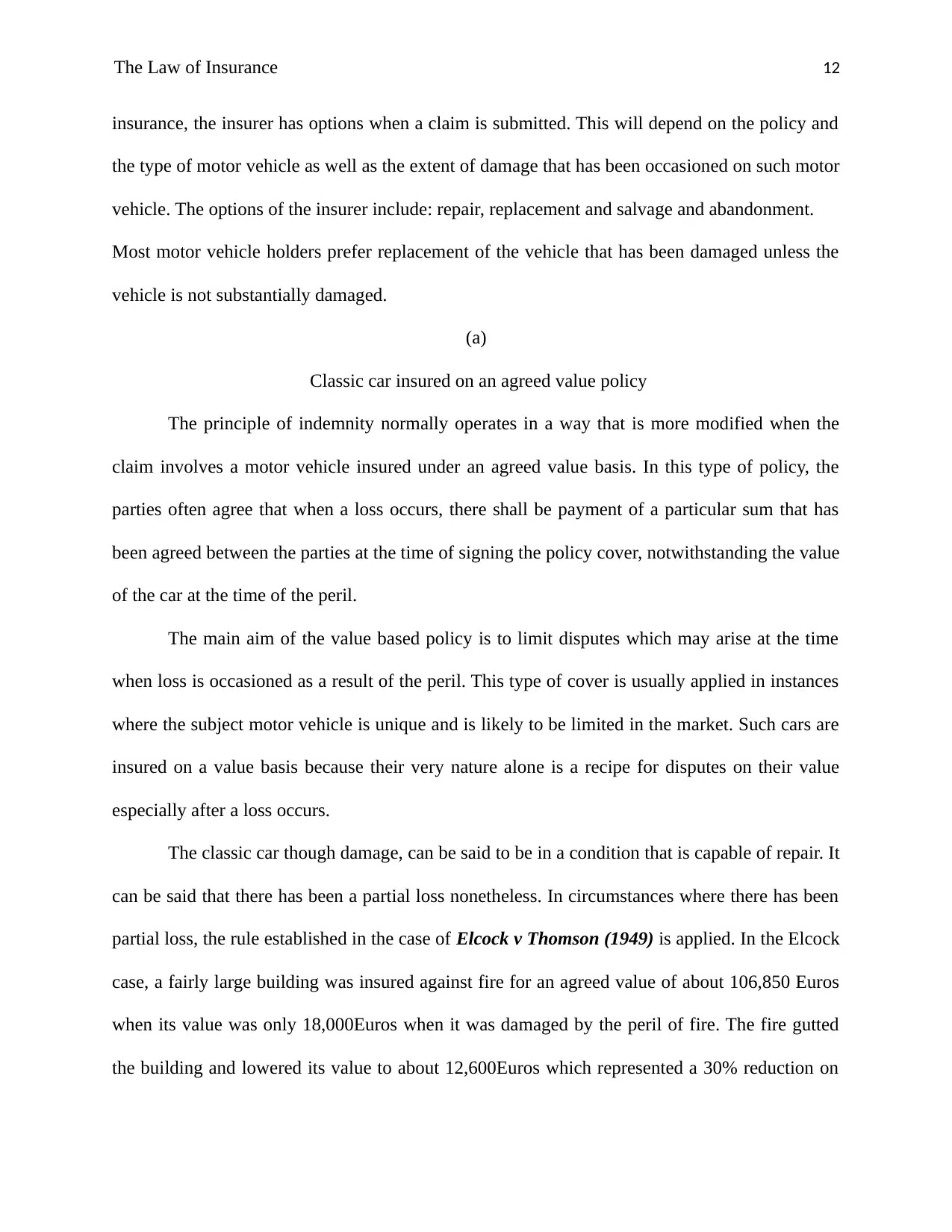
The Law of Insurance 12
insurance, the insurer has options when a claim is submitted. This will depend on the policy and
the type of motor vehicle as well as the extent of damage that has been occasioned on such motor
vehicle. The options of the insurer include: repair, replacement and salvage and abandonment.
Most motor vehicle holders prefer replacement of the vehicle that has been damaged unless the
vehicle is not substantially damaged.
(a)
Classic car insured on an agreed value policy
The principle of indemnity normally operates in a way that is more modified when the
claim involves a motor vehicle insured under an agreed value basis. In this type of policy, the
parties often agree that when a loss occurs, there shall be payment of a particular sum that has
been agreed between the parties at the time of signing the policy cover, notwithstanding the value
of the car at the time of the peril.
The main aim of the value based policy is to limit disputes which may arise at the time
when loss is occasioned as a result of the peril. This type of cover is usually applied in instances
where the subject motor vehicle is unique and is likely to be limited in the market. Such cars are
insured on a value basis because their very nature alone is a recipe for disputes on their value
especially after a loss occurs.
The classic car though damage, can be said to be in a condition that is capable of repair. It
can be said that there has been a partial loss nonetheless. In circumstances where there has been
partial loss, the rule established in the case of Elcock v Thomson (1949) is applied. In the Elcock
case, a fairly large building was insured against fire for an agreed value of about 106,850 Euros
when its value was only 18,000Euros when it was damaged by the peril of fire. The fire gutted
the building and lowered its value to about 12,600Euros which represented a 30% reduction on
insurance, the insurer has options when a claim is submitted. This will depend on the policy and
the type of motor vehicle as well as the extent of damage that has been occasioned on such motor
vehicle. The options of the insurer include: repair, replacement and salvage and abandonment.
Most motor vehicle holders prefer replacement of the vehicle that has been damaged unless the
vehicle is not substantially damaged.
(a)
Classic car insured on an agreed value policy
The principle of indemnity normally operates in a way that is more modified when the
claim involves a motor vehicle insured under an agreed value basis. In this type of policy, the
parties often agree that when a loss occurs, there shall be payment of a particular sum that has
been agreed between the parties at the time of signing the policy cover, notwithstanding the value
of the car at the time of the peril.
The main aim of the value based policy is to limit disputes which may arise at the time
when loss is occasioned as a result of the peril. This type of cover is usually applied in instances
where the subject motor vehicle is unique and is likely to be limited in the market. Such cars are
insured on a value basis because their very nature alone is a recipe for disputes on their value
especially after a loss occurs.
The classic car though damage, can be said to be in a condition that is capable of repair. It
can be said that there has been a partial loss nonetheless. In circumstances where there has been
partial loss, the rule established in the case of Elcock v Thomson (1949) is applied. In the Elcock
case, a fairly large building was insured against fire for an agreed value of about 106,850 Euros
when its value was only 18,000Euros when it was damaged by the peril of fire. The fire gutted
the building and lowered its value to about 12,600Euros which represented a 30% reduction on
⊘ This is a preview!⊘
Do you want full access?
Subscribe today to unlock all pages.

Trusted by 1+ million students worldwide
1 out of 25
Related Documents
Your All-in-One AI-Powered Toolkit for Academic Success.
+13062052269
info@desklib.com
Available 24*7 on WhatsApp / Email
![[object Object]](/_next/static/media/star-bottom.7253800d.svg)
Unlock your academic potential
Copyright © 2020–2025 A2Z Services. All Rights Reserved. Developed and managed by ZUCOL.




